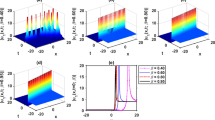Abstract
This study deals with a 3-D boundary-value problem that arises when free-surface waves interact with a stationary body or body system in a channel or wave tank of rectangular cross-section. A consistent asymptotic analysis and an efficient numerical solution is presented of the Green function that satisfies the linear free- surface condition and the non-penetration condition on the channel bottom and the sidewalls. The formulation is based on the open-sea Green function and the complete series of images is evaluated accurately based on the asymptotic analysis. It is demonstrated that the Green function has a square-root singular behavior due to the sidewalls when the wave frequency approaches one of the resonant frequencies. The numerical results for the Green function presented in this paper are believed to have an absolute accuracy of 10−5.
Similar content being viewed by others
References
P. M. Morse and H. Feshbach, Methods of Theoretical Physics (Part 1). New York: McGraw-Hill (1953) 997 pp.
X. B. Chen, On the side wall effects upon bodies of arbitrary geometry in wave tanks. Appl. Ocean Res. 16 (1994) 337–345.
M. Kashiwagi, Radiation and diffraction forces acting on an offshore-structure model in a towing tank. Int. J. Offshore Polar Eng. 1 (1991) 101–107.
J. H. Vazquez and A. N. Williams, Hydrodynamic loads on a three-dimensional body in a narrow tank. J. Offshore Mech. Arctic Eng. 116 (1994) 117–121.
J. H. Vazquez and A. N. Williams,Wave radiation by a three-dimensional body in a narrow tank. Ocean Eng. 22 (1995) 799–817.
C. M. Linton, On the free-surface GreenÆs function for channel problems. Appl. Ocean Res. 15 (1993) 263–267.
J. V. Wehausen and E. V. Laitone, Surface waves. In: S. Flugge (ed.), Handbuch der Physik 9 (III). Berlin: Springer-Verlag (1960) 446–815.
J. N. Newman, Algorithms for the free-surface Green function. J. Eng. Math. 19 (1985) 57–67.
F. John, On the motion of floating bodies (II. simple harmonic motions). Comm. Pure Appl. Math.3 (1950) 45–101.
J. N. Newman, Approximation of free-surface Green function. In: P. A. Martin and G. R. Whickham (eds.), Wave Asymptotics. Cambridge University Press (1992) 107–142.
J. G. Teste and F. Noblesse, Numerical evaluation of the Green function of water-wave radiation and diffraction. J. Ship Res. 30 (1986) 69–84.
M. Abramowitz and I. A. Stegun, Handbook of Mathematical Functions. New York: Dover (1972) 1046 pp.
A. Nayfeh, Perturbation Methods. New York: John Wiley and Sons (1973) 425pp.
H. Bateman, Higher Trascendental Functions (1). New York: McGraw-Hill (1953) 302 pp.
R. Eatock Taylor and S. M. Hung, Mean drift forces on an articulated column oscillating in a wave tank. Appl. Ocean Res. 7 (1985) 66–78.
R.W. Yeung and S. H. Sphaier,Wave-interference effects on a truncated cylinder in a channel. J. Eng. Math. 23 (1989) 95–117.
M. K. Pidcock, The calculation of Green functions in three-dimensional hydrodynamic gravity problems. Int. J. Num. Meth. Fluids 5 (1985) 891–909.
Author information
Authors and Affiliations
Rights and permissions
About this article
Cite this article
Xia, J. Evaluation of the Green function for 3-D wave-body interactions in a channel. Journal of Engineering Mathematics 40, 1–16 (2001). https://doi.org/10.1023/A:1017533115478
Issue Date:
DOI: https://doi.org/10.1023/A:1017533115478




